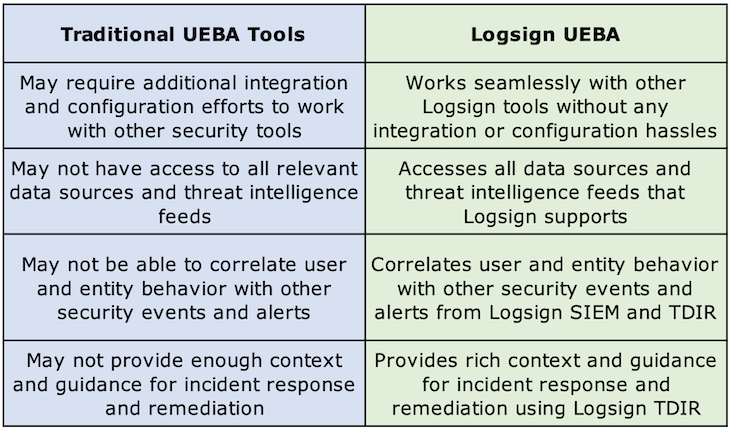Unlocking the Potential of UEBA With Logsign


In today's cybersecurity landscape, traditional security tools alone are inadequate in protecting organizations from advanced threats like data breaches, insider risks, and more.
To effectively address these challenges, organizations require a comprehensive solution with UEBA (user and entity behavior analytics) capabilities.
Let's discover the benefits of UEBA, and the unparalleled impact Logsign’s Unified Security Operations Platform has on UEBA.

UEBA (user and entity behavior analytics) leverages advanced analytics and machine learning techniques to gather vast amounts of data pertaining to user activities and behavior of various entities within a corporate network or system.
By closely examining this information, UEBA strives to identify anomalies, deviations, or patterns that could indicate potential security risks.
UEBA aids in the detection of both internal and external potential threats. Internal threats refer to potential risks posed by authorized users, such as employees, who may abuse their privileges or inadvertently become compromised. While external threats encompass malicious actors attempting to infiltrate the system or exploit vulnerabilities.
By utilizing UEBA software, organizations can bolster their security posture, proactively respond to threats, and minimize the potential impact of cyberattacks.

Logsign’s Unified Security Operations Platform is not just a collection of cybersecurity tools; it represents a paradigm shift in the way organizations approach security.
With an unwavering focus on innovation and a deep understanding of the ever-evolving threat landscape, Logsign has created a solution that goes beyond traditional.
The Logsign USO Platform brings together a diverse range of cutting-edge cybersecurity tools, such as security information and event management (SIEM), threat intelligence, user entity behavior analytics (UEBA), and Threat Detection, Investigation, and Response (TDIR) and seamlessly integrates them into a single, cohesive platform.
At the heart of the Logsign USO Platform lies its innovative user and entity behavior analytics (UEBA) functionality. This integration enables security teams to have a holistic view of their organization's security posture and proactively identify threats and mitigate risks before they escalate into significant incidents.
Logsign UEBA collects data from various sources, such as logs, network traffic, endpoints, cloud services, behavioral patterns, and threat intelligence feeds. It then applies machine learning algorithms to establish baselines of normal behavior for users and entities.
It also maps the behavior to the MITRE ATT&CK framework, which is a globally recognized knowledge base of adversary tactics and techniques.
By comparing current behavior with the baselines and framework, Logsign UEBA can utilize anomaly detection capabilities to identify deviations that may indicate malicious activity.
For example, this system can detect suspicious user types, unauthorized access to sensitive data or systems, unusual tools or commands, communication with malicious domains or IP addresses, and signs of compromise or infection.
Logsign UEBA then prioritizes alerts based on the severity and risk level of the anomalies.
It also provides you with contextual information about the user or entity involved, such as their role, location, and device type. This helps you understand the scope and impact of the incident and take appropriate actions to contain and remediate it.
But what is Logsign UEBA’s role in improving your cybersecurity posture? What are the benefits of using it? Let’s explore!

Logsign UEBA offers many benefits for organizations' cybersecurity posture, such as:

Logsign UEBA is not just another UEBA tool. It is a UEBA tool that is integrated into a unified security operations platform. This means that it can leverage the data and capabilities of other Logsign tools, such as SIEM, threat intelligence, and TDIR, to provide you with a more holistic security solution.
Traditional UEBA tools may have some limitations, such as:
Here is a comparison table that summarizes the differences between traditional UEBA tools and Logsign UEBA.

Logsign UEBA offers many advantages over traditional UEBA security tools. But that's not all. Logsign’s USO Platform also offers other benefits that make it a superior solution compared to other tools, such as:
Cybersecurity is not a one-size-fits-all solution. You need a solution that can adapt to your specific needs and challenges. You need a Unified Security Operations Platform.
If you are interested in unlocking the potential of UEBA with the Logsign Unified Security Operations Platform, you can request a demo today.